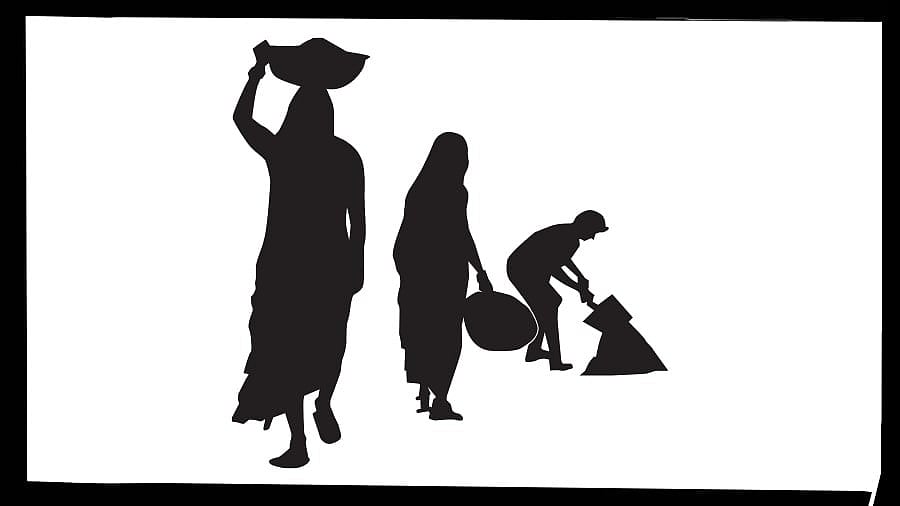
This year marks the 20th anniversary of a landmark statutory right established by Parliament. This is the right to work, or the right to employment. Such a right is envisaged in Article 41 of the Constitution which directs all states to secure a right to work, for all citizens.
This law was created as the Mahatma Gandhi National Rural Employment Guarantee Act which was passed in Parliament on August 23, 2005. It gave the right to a hundred days of unskilled manual work at a specified daily wage, for one member of every rural household that asked for it.
One-third of these jobs created were to be reserved for women. Employment is to be given within 5 kilometres of the applicant’s residence.
And if the government is unable to create such employment, it has to give some allowance instead of wages. This is the biggest social security and public works programme in the world. Despite early scepticism, it is now universally hailed as a stellar development programme even by the World Bank.
The provision of rural jobs on demand is a proxy for unemployment insurance. In developed countries, an unemployed person goes and registers himself or herself at the employment exchange, and while looking for a job, gets an unemployment dole. India does not have such a system since the labour market is not as well organised. Instead, we have the MGNREGA scheme (also sometimes called MGNREGS) which covers the rural population.
The MGNREGS employment demand spikes up during droughts and famines and that is why it is an “insurance” programme de facto. The demand for MGNREGS falls when labour market conditions improve and there is plenty of work available for farm labour.
If the MGNREGS demand falls, it is a good sign. If the programme becomes redundant, it would mean that rural India has reached full employment conditions. But we are far from that situation. Most recently during the pandemic, the demand for MGNREGS rose steeply, and the total expenditure in fiscal year 2020-21 was double what was budgeted, reaching almost Rs 1.2 lakh crore, and generating 300 crore person days of work.
MGNREGS provides employment during distress. The wages are linked to minimum wages, ensuring that it acts as an anti-poverty measure. Women’s participation is high, empowering them politically and giving them autonomy. Many work sites provide creche services, to help women with young children to participate. The public works programmes created to provide MGNREGS work build public assets such as irrigation reservoirs, ponds, canals, rural roads, and afforestation.
In some states, the programme also includes building rural housing or private assets. The availability of work in rural areas reduces the stress of urban migration on cities. During the pandemic, there was large-scale reverse migration to the villages, where people were provided work under MGNREGS. Since workers’ rights are enshrined in the law, they have a much better chance of securing those rights. Thanks to Aadhaar linkage, the payment of wages is directly deposited into bank accounts reducing leakage.
What about the negatives? Firstly, since it is a labour market intervention providing a wage floor and an alternative option, the landlords and those who seek labourers are upset. Since the wages are minimum wages under MGNREGS, the alternative work needs to offer higher wages to lure workers away.
Secondly, despite controls and biometric tools, there are still alleged leakages of funds that include methods like phantom musters of workers which help in siphoning out money. This leakage can be prevented only by permitting social audits by the villagers or non-government organisations. A third drawback is due to biometric requirements. If the thumbprint or retina reader does not work, or if there is a failure of electricity or the machine, the worker is denied wages. Even if there is a 2% error rate, it could result in 10 or 20 million workers being denied. A fourth drawback and a recent worrying trend is the delay in payments. Since these are daily-wage workers, any delay beyond one or two weeks can be distressing.
Government data shows an aggregate of Rs 975 crore in payments has
been delayed.
Creating assets, inspiring schemes
Many features of MGNREGS can be tweaked and reformed to make it even more effective. It is different from Universal Basic Income (UBI) which is an unconditional money transfer. By contrast, MGNREGS is for self-selected individuals and has a requirement of hard manual labour. Presumably, this filters out the fake and fraudulent claimants, if the system works properly. One measure of the success of MGNREGS is that there is often a demand for an urban equivalent.
MGNREGS was the culmination of public works programmes, experiments, and pilot projects that started as early as the 1960s, with some degree of success. Maharashtra’s Employment Guarantee Scheme was launched in 1973 against the backdrop of a severe multi-year drought. It was financed by the state itself by imposing a professional tax on those employed in cities. It ran well and was an inspiration to the national law. Until the time that India has a full-fledged formal unemployment insurance with extensive registration and tracking of the employed and the unemployed workers, and a payroll tax collected from employers to pay for this, a scheme like MGNREGS will be essential.
The additional impact of free foodgrains (5 kg per person per month) and various direct benefit transfer schemes like PM Kisan or the Ladki Bahin Yojana is such that the need for MGNREGS will decline. Not to forget that MGNREGS, due to its work requirement, creates durable rural assets that add to productivity and public welfare. It also acts as an indirect vehicle for women’s empowerment. It has been a role model for the world and on its 20th anniversary, concerted efforts need to be in place to make it more effective.
(The writer is an economist; Syndicate: The Billion Press)